
Understanding Flood Risks and Preparedness
Floods, a common yet devastating natural disaster, require thorough understanding and preparedness. Recognizing high-risk areas and having access to early warning systems are crucial steps in reducing flood impacts. Preparedness starts with having a comprehensive plan that includes evacuation routes, emergency contacts, and a safe meeting place. Assess the safety of your home or workplace, ensuring structural stability and relocating valuable items to higher ground. Familiarizing yourself with local emergency procedures will strengthen your readiness. Regular drills and updates to emergency kits are vital, incorporating essentials like food, water, and first-aid supplies. Understanding flood risks can greatly minimize damage, prevent loss of life, and enable quicker recovery. Community involvement in flood preparedness can also enhance collective safety and resilience, ensuring all are equipped to face potential challenges.
Essential Clothing for Flood Conditions
When facing flood conditions, selecting appropriate clothing is essential for safety and comfort. Waterproof and breathable materials are crucial to protect against prolonged exposure to rain and floodwaters while keeping body temperature regulated. Lightweight, quick-drying fabrics help maintain comfort and mobility. Layering is important, offering flexibility as conditions change, with moisture-wicking base layers to keep dry. Insulated outer layers provide warmth, preventing hypothermia. High-visibility clothing ensures individuals are easily seen, particularly during emergency situations or low-visibility conditions. It’s important to avoid cotton, as it absorbs water and dries slowly, increasing the risk of hypothermia. Ensuring your clothing is durable and resistant to tearing or damage is vital for long-lasting protection. Proper clothing can significantly impact your ability to move safely and stay warm during floods, making it a key component in flood preparedness.
Footwear Designed for Wet, Slippery Environments
Footwear plays a critical role during floods, as it needs to provide stability, protection, and comfort in wet, slippery environments. Shoes with non-slip soles offer better traction, reducing the risk of falls and injuries. Waterproof materials such as rubber or fully sealed boots prevent water ingress, keeping feet dry and reducing discomfort or potential hypothermia. It’s essential to choose durable footwear that can withstand rough terrain and debris commonly encountered in floodwaters. Lightweight designs enhance mobility and reduce fatigue during extended wear. Properly fitted shoes that support the ankle can further prevent injuries. Removable insoles that dry quickly provide additional convenience in maintaining hygiene and comfort. Prioritizing the selection of appropriate footwear can significantly improve safety and mobility in flood situations, offering protection against the unique challenges posed by wet environments.
Protective Gear for Waterborne Hazards
Floodwaters can pose serious health risks due to waterborne hazards such as pathogens, chemicals, and debris. Protective gear is vital for reducing exposure to these hazards. Personal protective equipment (PPE) like gloves and masks can offer significant protection. Gloves prevent contact with contaminated surfaces and submerged hazards, while masks can help filter airborne pathogens. Goggles or protective eyewear shield eyes from debris and splashes. For added safety, a waterproof suit can protect against prolonged exposure to contaminated water. It’s important to ensure all gear is well-maintained and correctly fitted for maximum efficiency. Familiarize yourself with proper cleaning techniques to remove contaminants post-exposure. Utilizing adequate protective gear during floods not only protects health but also helps individuals carry out necessary tasks without compromising safety, making them an indispensable part of flood readiness.
Importance of Waterproof Electronics
In flood conditions, the role of waterproof electronics is paramount. Devices such as waterproof phones, radios, and flashlights make communication and navigation possible even when submerged in water. These gadgets often have protective casings and durable seals, allowing them to function reliably in wet conditions. A solar charger or backup power source is valuable, catering to prolonged outage scenarios. Waterproof GPS systems assist in safe navigation and locating vital resources, while reliable lighting ensures visibility in low-light circumstances. Learning the operation of such devices can amplify their utility during emergencies. In flood situations, effective communication and situational awareness provided by waterproof electronics are critical. They help individuals stay connected with emergency services and loved ones, laying the groundwork for timely assistance and informed decision-making, which are essential for survival and rescue operations.
Emergency Tools and Equipment to Carry
Carrying the right emergency tools and equipment during floods can be life-saving. A well-prepared emergency kit should include items like a multi-tool, rope, and battery-powered or hand-crank radio. These tools assist in various tasks, from repairs and rope rescue operations to staying updated on emergency broadcasts. A portable water filter or purification tablets ensure access to safe drinking water—critical in flood events. Flashlights and matches or lighters provide light and heat, valuable commodities in power outages. Essential tools also include a whistle for signaling distress and a first aid kit for immediate medical attention. Having these items readily available increases preparedness and response times, minimizing risks and enhancing safety. Regularly checking and updating this kit is essential to ensure equipment is in working condition and accessible when most needed during flood emergencies.
